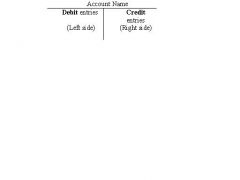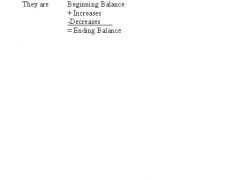![]()
![]()
![]()
Use LEFT and RIGHT arrow keys to navigate between flashcards;
Use UP and DOWN arrow keys to flip the card;
H to show hint;
A reads text to speech;
27 Cards in this Set
- Front
- Back
|
What is a journal?
|
A journal is a record in which transactions are initially recorded in chronological order
|
|
|
What is a journal entry?
|
A journal entry is the record of a single transaction that in entered in a company’s journal.
|
|
|
What is a general ledger?
|
The general ledger is the primary record of a company’s financial information. It contains all the accounts maintain by the company – asset, liability, equity, revenue and expense accounts.
|
|
|
What is posting?
|
Posting is the process of transferring the amount from the journal to the general ledger.
|
|
|
What is a chart of account?
|
All of a company’s accounts can be found on the company’s chart of accounts. A chart of accounts is a list of all the accounts in a firm’s accounting records along with account numbers to assist in maintaining accurate accounting records.
|
|
|
How do accountants record transactions?
|
The method accountants use to record transactions in the journal and post them to the general ledger is called double-entry bookkeeping. The word “double” is used because each dollar amount in a transaction will be recorded in at least two accounts.
|
|
|
What is a debit?
|
Debit – the left side of an account.
|
|
|
What is a credit?
|
Credit – the right side of an account.
|
|
|
How does a debit affect an asset account?
|
Assets are increased with debits and decreased with credits.
|
|
|
How does a debit affect a liability or a shareholder's equity account?
|
Liabilities and shareholders’ equity are increased with credits and decreased with debits
|
|
|
What is a normal balance?
|
A normal balance is the increase side of an account.
|
|
|
How does a debit affect a revenue?
|
Revenues are increased with credits and decreased with debits.
|
|
|
How does a debit affect an expense?
|
Expenses are increased with debits and decreased with credits.
|
|
|
What is the accounting cycle?
|
The accounting cycle is the steps an accountant follows to analyze and record business transactions, prepare the financial statements, and get ready for the next accounting period
|
|
|
What is the first step in the accounting cycle?
|
The first step is the cycle is to analyze and record transactions in the journal.
|
|
|
What is the second step in the accounting cycle?
|
The second step is to post the journal entries to the general ledger.
|
|
|
What does posting mean?
|
Posting – transferring the amounts from journal entries to the general ledger accounts.
|
|
|
What is the third step in the accounting cycle?
|
The third step is to prepare an unadjusted trial balance at the end of the accounting period.
|
|
|
What is a trial balance?
|
A trial balance is a list of all the accounts in the general ledger with the respective debit or credit balances at a given point in time. The trial balance ensures debits = credits in the accounting records.
|
|
|
How are debits and credits used in a journal entry?
|
The general ledger’s system of debits and credits will have the dollar amount of debits equal to the dollar amount of credits in every journal entry.
|
|
|
What is the format of preparing a journal entry?
|
Debits are always listed first, and credits are listed after all the debits.
|
|
|
What is working capital?
|
Working capital is a measure used to evaluate liquidity.
|
|
|
How do you compute working capital?
|
Working capital = Current assets – Current liabilities
|
|
|
What is a quick ratio?
|
Quick ratio is a measure of a company’s ability to meet its short-term obligations.
It is also known as the acid-test ratio. |
|
|
What balance sheets accounts are included in a quick ratio?
|
Quick ratio = Cash, accounts receivable, and short-term investments divided by current liabilities.
|
|
|
What is a T Account?
|

T-accounts are used to represent a page in the general ledger. The left side is the debit side and the right side is the credit side.
|
|
|
How do you calculate an account balance?
|

Every account balance is derived from four components
|

